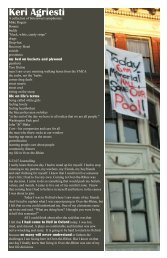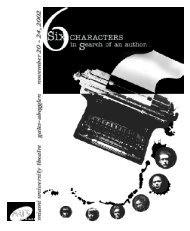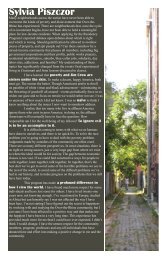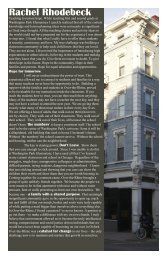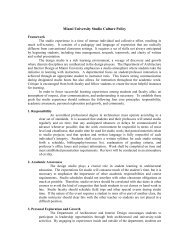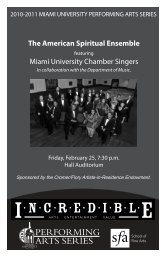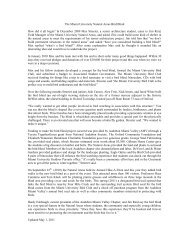Bourbon at the Border - Miami University School of Fine Arts
Bourbon at the Border - Miami University School of Fine Arts
Bourbon at the Border - Miami University School of Fine Arts
You also want an ePaper? Increase the reach of your titles
YUMPU automatically turns print PDFs into web optimized ePapers that Google loves.
MIAMI UNIVERSITY DEPARTMENT OF THEATRE presents<br />
1<br />
<strong>Bourbon</strong> <strong>at</strong> <strong>the</strong> <strong>Border</strong><br />
By Pearl Cleage<br />
Directed by Paul K. Jackson<br />
Steven R. Pauna, Scenic Designer & Technical Director<br />
Meggan Peters, Costume Designer<br />
Jay Rozema, Lighting & Sound Designer<br />
lighting design assisted by K<strong>at</strong>ie Johnson<br />
Emily Ruth Williams, Stage Manager<br />
Produced by special arrangement with Rosenstone/Wender
2<br />
A SPECIAL THANKS to<br />
Dr. Rinda Frye, guest vocal/performance consultant,<br />
<strong>University</strong> <strong>of</strong> Louisville<br />
Dr. Mia Biran, guest consultant on psychological issues rel<strong>at</strong>ed to <strong>the</strong> play<br />
<strong>Miami</strong> <strong>University</strong><br />
Ann Elizabeth Armstrong for overseeing <strong>the</strong> content and organiz<strong>at</strong>ion <strong>of</strong> <strong>the</strong><br />
dram<strong>at</strong>urgy for this Program Guide<br />
Performance Guide Editor<br />
Lisa A. Campbell<br />
Dram<strong>at</strong>urgy<br />
Andrew Beal<br />
Amy Foster<br />
Dr. Paul Jackson<br />
May I-3<br />
“The Green Dress”<br />
Costume Rendering<br />
by<br />
Meggan Peters<br />
THEATRE ETIQUETTE<br />
• Please turn <strong>of</strong>f all cell phones and pagers.<br />
• The taking <strong>of</strong> photographs or use <strong>of</strong> recording devices is strictly prohibited.<br />
• If you have candy to unwrap, kindly do so now.<br />
• Please note <strong>the</strong> closest exit in case <strong>of</strong> an emergency.<br />
• Smoking is not permitted in <strong>the</strong> Center for Performing <strong>Arts</strong>.<br />
• Please discard all food and drinks before entering <strong>the</strong> <strong>the</strong><strong>at</strong>re.<br />
• As a courtesy to <strong>the</strong> audience and performers, all l<strong>at</strong>ecomers will not be<br />
se<strong>at</strong>ed until an appropri<strong>at</strong>e break in <strong>the</strong> performance.<br />
SPECIAL EVENTS<br />
Please join us for an Opening Night reception, immedi<strong>at</strong>ely following <strong>the</strong><br />
show on October 27, in <strong>the</strong> Green Room <strong>of</strong> <strong>the</strong> CPA.<br />
There will be a Talk Back with <strong>the</strong> cast, designers and director following <strong>the</strong><br />
m<strong>at</strong>inee performance on S<strong>at</strong>urday, October 30.
3<br />
Performance Guide CONTENTS<br />
Director Notes 4<br />
Exploring Cultural Spaces <strong>of</strong> Pearl Cleage 5<br />
1954-1994: 40 Years <strong>of</strong> Civil Rights 6<br />
Synopsis <strong>of</strong> Scenes/Cast List 8<br />
Who’s Who in <strong>the</strong> Cast 9<br />
The Racial Chasm 11<br />
Hitsville, USA & Motown Records 13<br />
Designer Notes 14<br />
Company Credits 16<br />
Charlie I-1<br />
“Coming Home”<br />
Costume Rendering<br />
by<br />
Meggan Peters
4<br />
DIRECTOR’S NOTES<br />
<strong>Bourbon</strong> <strong>at</strong> <strong>the</strong> <strong>Border</strong> is a memory play...<br />
I have only been to Detroit once. But, perhaps we all live in Detroit or in its shadow. I remember in high school, or so I think<br />
it was… rejoicing in <strong>the</strong> election <strong>of</strong> Detroit’s first African American mayor. It seemed, to me, a n<strong>at</strong>ural progression <strong>of</strong> <strong>the</strong><br />
civil rights movement, a signifier <strong>of</strong> King’s dream. Then…I remember a news story about school buses burning in Pontiac…<br />
My first car was a Ford Pinto, built in Detroit I suppose. The Pinto was <strong>the</strong> car th<strong>at</strong> when rear-ended could instantly become<br />
an immol<strong>at</strong>ion device. I loved th<strong>at</strong> car…<br />
A colleague tells me th<strong>at</strong> Fordism refers to an economic system where assembly line production combined with high wages<br />
enabled many workers to buy <strong>the</strong> American Dream. White men benefited more than non-whites and women during this<br />
so-called golden age <strong>of</strong> <strong>the</strong> 1950’s.<br />
Times have changed.<br />
While <strong>at</strong> Wharton, during <strong>the</strong> so-called halcyon Reagan era, I remember no one wanted to talk to <strong>the</strong> GM recruiter from<br />
Detroit.<br />
Has Detroit been rendered obsolete as Exxonworld, Toyotaworld, and Dellword and o<strong>the</strong>r such worlds have transported,<br />
transl<strong>at</strong>ed, and transloc<strong>at</strong>ed Fordism into a new economic equ<strong>at</strong>ion?<br />
Wh<strong>at</strong> is <strong>the</strong> domestic response, <strong>the</strong> discourse, <strong>the</strong> condition, around race, economics, and displacement, in a global context,<br />
to <strong>the</strong> de-Detroitaliz<strong>at</strong>ion? Is it violence? If it is, <strong>the</strong>n…do we all live in Baghdad or in its shadow?<br />
Burning crosses, burning buses, burning cities, burning people…<br />
Who is sitting next to you?<br />
DIRECTOR’S BIO<br />
Paul K. Jackson (Director) is currently a Pr<strong>of</strong>essor <strong>of</strong> The<strong>at</strong>re <strong>at</strong> <strong>Miami</strong> <strong>University</strong>. Prior to coming to <strong>Miami</strong>, he was an Associ<strong>at</strong>e<br />
Pr<strong>of</strong>essor and Chair <strong>at</strong> Spelman College. His <strong>the</strong><strong>at</strong>re and performance interests center on <strong>the</strong> African Diaspora, post and neo colonialism<br />
and issues <strong>of</strong> race, class, gender and sexuality. His work as a director mirrors <strong>the</strong>se interests. In 2002, he directed Suzan-Lori Parks’<br />
Venus. He is co-editor <strong>of</strong> Intersecting Boundaries: The The<strong>at</strong>re <strong>of</strong> Adrienne Kennedy. Recently he has given lectures <strong>at</strong> Ohio St<strong>at</strong>e and<br />
<strong>at</strong> <strong>the</strong> <strong>University</strong> <strong>of</strong> Massachusetts on Kennedy, an Ohio n<strong>at</strong>ive. He has also been Guest Pr<strong>of</strong>essor <strong>at</strong> Mount Holyoke College. In 1994<br />
he received a grant from <strong>the</strong> Consortium for Inter-Institutional Collabor<strong>at</strong>ion in African and L<strong>at</strong>in American Studies to Study Portuguese<br />
language and Brazilian Culture <strong>at</strong> Michigan St<strong>at</strong>e <strong>University</strong> and l<strong>at</strong>er in Brazil. In July 1994, he presented <strong>the</strong> opening paper <strong>at</strong> <strong>the</strong><br />
Fourth Intern<strong>at</strong>ional The<strong>at</strong>re Conference <strong>at</strong> <strong>the</strong> Federal <strong>University</strong> <strong>of</strong> Bh<strong>at</strong>ia (UFBA) Salvador, where he was also adjunct pr<strong>of</strong>essor. He<br />
has received grants from The N<strong>at</strong>ional Endowment for <strong>the</strong> Humanities, The Ford Found<strong>at</strong>ion, and <strong>the</strong> Coca-Cola Found<strong>at</strong>ion. He is an<br />
active member <strong>of</strong> N<strong>at</strong>ional Associ<strong>at</strong>ion <strong>of</strong> <strong>School</strong>s <strong>of</strong> The<strong>at</strong>re, <strong>the</strong> Associ<strong>at</strong>ion for The<strong>at</strong>re in Higher Educ<strong>at</strong>ion, <strong>of</strong> which he presently serves<br />
on <strong>the</strong> Str<strong>at</strong>egic Planning Committee, <strong>the</strong> Black The<strong>at</strong>re Network, and <strong>the</strong> Modern Language Associ<strong>at</strong>ion. He acknowledges among his<br />
mentors <strong>the</strong> recently departed Vinnette Carroll (Don’t Bo<strong>the</strong>r Me I Can’t Cope and Your Arms are too Short to Box with God), one <strong>of</strong><br />
only two African American women to have directed on Broadway. He is currently <strong>at</strong> work editing <strong>the</strong> third annual edition <strong>of</strong> Blackstream,<br />
a journal devoted to <strong>the</strong> conference papers <strong>of</strong> <strong>the</strong> Black The<strong>at</strong>re Associ<strong>at</strong>ion (ATHE). He is also completing a history <strong>of</strong> African American<br />
The<strong>at</strong>re with African/African American historian Alphine Jefferson and emeritus <strong>the</strong><strong>at</strong>re pr<strong>of</strong>essor Arnetta Jefferson (both <strong>of</strong> Wooster<br />
College) to be published in 2004. He is also completing a study devoted to public space, resistance, performance and neo colonialism<br />
with urban geographer James Engstrom. Chapters have been presented <strong>at</strong> both ATHE and <strong>the</strong> Associ<strong>at</strong>ion <strong>of</strong> American Geographers.
I dedic<strong>at</strong>e my work in <strong>Bourbon</strong> <strong>at</strong> <strong>the</strong> <strong>Border</strong> to all my womanist and feminist sisters<br />
from,<br />
a comrade<br />
5<br />
EXPLORING THE CULTURAL SPACES OF PEARL CLEAGE BY PAUL K. JACKSON, PH. D.<br />
Pearl Cleage is a serious writer, and her plays reflect a century <strong>of</strong> political and social progress, change, struggle, awareness,<br />
denial, failure and triumph <strong>of</strong> <strong>the</strong> lives <strong>of</strong> African American women and men. Ms. Cleage st<strong>at</strong>es,” as a third-gener<strong>at</strong>ion<br />
black n<strong>at</strong>ionalist and a radical feminist, <strong>the</strong> primary energy th<strong>at</strong> fuels my work is a determin<strong>at</strong>ion to be part <strong>of</strong> <strong>the</strong> ongoing<br />
worldwide struggle against racism, sexism, classism, and homophobia. I approach my work first as a way <strong>of</strong> expressing my<br />
emotional response to oppression, since no revolution has ever been fueled purely by intellect, no m<strong>at</strong>ter wh<strong>at</strong> <strong>the</strong> boys<br />
tell you; second, as a way to <strong>of</strong>fer analysis, establish context, and clarify point <strong>of</strong> view; and third to incite my audiences or<br />
my readers to action. My work is deeply rooted in, and consciously reflective <strong>of</strong> African American history and culture since<br />
I believe th<strong>at</strong> it is by accur<strong>at</strong>ely expressing our very specific and highly individual realities th<strong>at</strong> we discover our common<br />
humanity.” (Contemporary Plays by Women <strong>of</strong> Color, Routledge, Perkins and Uno) Flyin’ West (1992) Blues for an<br />
Alabama Sky (1995), and <strong>Bourbon</strong> <strong>at</strong> <strong>the</strong> <strong>Border</strong> (1997) each contribute to Pearl’s political/dram<strong>at</strong>urgical vision. These plays<br />
revisit, recre<strong>at</strong>e, and reanim<strong>at</strong>e challenging historical spaces in such a way th<strong>at</strong> <strong>the</strong>y compel <strong>the</strong> audience to reconsider those<br />
central questions <strong>of</strong> gender, race, and community identity within a paradigm <strong>of</strong> past, present, and future.<br />
These plays also reflect a tradition <strong>of</strong> African American women in <strong>the</strong> <strong>the</strong><strong>at</strong>re th<strong>at</strong> spans <strong>the</strong> 20 th century. To loc<strong>at</strong>e <strong>the</strong><br />
space <strong>of</strong> Ms. Cleage within a tradition <strong>of</strong> African American playwrights is first to look <strong>at</strong> <strong>the</strong> plays included in <strong>the</strong> volume<br />
<strong>of</strong> her plays Flyin’ West and o<strong>the</strong>r Plays (TCG 1999). An interesting and important observ<strong>at</strong>ion can be made in th<strong>at</strong> her<br />
first major play puppetplay, which opened <strong>the</strong> 1983, 17 th , season <strong>of</strong> <strong>the</strong> Negro Ensemble Company in New York City, is not<br />
included in <strong>the</strong> collection. The play, a fanciful non-realistic drama th<strong>at</strong> investig<strong>at</strong>es rel<strong>at</strong>ionships and employs a marionette to<br />
do so, received mixed reviews. In an interview with Freda Scott Giles, Pr<strong>of</strong>essor <strong>of</strong> The<strong>at</strong>re <strong>at</strong> <strong>the</strong> <strong>University</strong> <strong>of</strong> Georgia, Ms.<br />
Cleage speaks about <strong>the</strong> play. “Most people are not enamored <strong>of</strong> new forms. Using traditional forms gives me more power<br />
in taking <strong>the</strong> audience’s defenses away.” It is not surprising <strong>the</strong>n to see th<strong>at</strong> given <strong>the</strong> experience <strong>of</strong> puppetplay, Pearl,<br />
politically and str<strong>at</strong>egically decides to embrace a tradition <strong>of</strong> African American women playwrights th<strong>at</strong> include those <strong>of</strong> <strong>the</strong><br />
Harlem Renaissance: Angelina Grimke and Mary Burrill (1901), those <strong>of</strong> <strong>the</strong> U.S. Civil Rights era: Alice Childress, and Lorraine<br />
Hansberry and her contemporaries Kia Cothorn and Rhodessa Jones. These “warrior women, ” who prefer <strong>the</strong> textual<br />
clarity and pragm<strong>at</strong>ism <strong>of</strong> social realism over non-realistic drama and who choose <strong>the</strong> most pressing issues <strong>of</strong> our day,<br />
including lynching, prison, abortion, questions <strong>of</strong> identity, enslavement and <strong>the</strong> ghosts <strong>of</strong> its afterm<strong>at</strong>h, sexuality, colonialism,<br />
n<strong>at</strong>ionalism, and integr<strong>at</strong>ion to confront <strong>the</strong>ir audiences, presage and reflect <strong>the</strong> dramas <strong>of</strong> Ms. Cleage. Fur<strong>the</strong>rmore, it<br />
can be entertained th<strong>at</strong> given Cleage’s n<strong>at</strong>ionalist and feminist desires to address global concerns and foment community<br />
around central issues th<strong>at</strong> <strong>the</strong> playwright chooses a dram<strong>at</strong>ic form th<strong>at</strong> embraces all and not only <strong>the</strong> inner circle <strong>of</strong> <strong>the</strong><br />
<strong>the</strong><strong>at</strong>re-going community. It is simultaneously important to note th<strong>at</strong> Pearl Cleage sees her first audience as th<strong>at</strong> <strong>of</strong> African<br />
American women.<br />
Within this context <strong>of</strong> dram<strong>at</strong>ic and literary tradition and “warrior women,” Ms. Cleage recre<strong>at</strong>es and constructs African<br />
American historical and cultural spaces, familiar yet “strange,” in which to set her plays. Violence marks and reson<strong>at</strong>es within<br />
those spaces. In Flyin’West, it is a space in Nicodemus, Kansas where recently freed Africans <strong>at</strong>tempt to cre<strong>at</strong>e “home” while<br />
carrying <strong>the</strong> ghosts and violence <strong>of</strong> enslavement on <strong>the</strong>ir backs. In Blues for an Alabama Sky, it is a space in Harlem during<br />
<strong>the</strong> Harlem Renaissance where community dreams <strong>of</strong> social change and racial uplift and personal dreams <strong>of</strong> fame, fortune<br />
and glamour are ei<strong>the</strong>r legisl<strong>at</strong>ed against, violently ended or only <strong>at</strong>tainable through <strong>the</strong> culturally violent process <strong>of</strong> leaving<br />
home--becoming an ex p<strong>at</strong>ri<strong>at</strong>e, and in <strong>Bourbon</strong> <strong>at</strong> <strong>the</strong> <strong>Border</strong>, it is a “homespace” haunted by <strong>the</strong> memory <strong>of</strong> violence th<strong>at</strong><br />
occurred in <strong>the</strong> basement <strong>of</strong> a Mississippi jail during Freedom Summer 30 years earlier.
6<br />
Ms. Cleage’s spaces <strong>of</strong> history, marked by violence, encompass, chronicle and reflect a Diasporic experience and culture<br />
th<strong>at</strong> are fur<strong>the</strong>r marked by struggle. The playwright constructs character, language and action to underscore th<strong>at</strong> reality. It<br />
is <strong>the</strong>refore not <strong>at</strong> all uncommon in Ms. Cleage’s plays to see a moment <strong>of</strong> gre<strong>at</strong> joy suddenly confronted by gre<strong>at</strong> sorrow<br />
or anger (<strong>Bourbon</strong> <strong>at</strong> <strong>the</strong> <strong>Border</strong>)--<strong>the</strong> birth <strong>of</strong> a new gener<strong>at</strong>ion overshadowed by an abusive rel<strong>at</strong>ionship (Flyin’ West),<br />
or a joyous party suddenly ended by homophobia (Blues for an Alabama Sky). Notice how quickly <strong>the</strong> “dreams” <strong>of</strong> <strong>the</strong><br />
characters in Blues For an Alabama Sky appear to be sh<strong>at</strong>tered by one bullet, and <strong>the</strong> dreams <strong>of</strong> a new job or a new<br />
beginning are sh<strong>at</strong>tered by a forgotten note (<strong>Bourbon</strong> <strong>at</strong> <strong>the</strong> <strong>Border</strong>). One important fe<strong>at</strong>ure <strong>of</strong> <strong>the</strong>se spaces in rel<strong>at</strong>ion to<br />
<strong>the</strong> culture and struggle <strong>of</strong> <strong>the</strong> African American Diasporic experience is th<strong>at</strong> <strong>the</strong>se spaces can be both remarkably complex<br />
and remarkably simple. They are <strong>at</strong> times transhistorical. They are even <strong>at</strong> times magical. So do not dismiss actions or<br />
events as being too simplistic or overly melodram<strong>at</strong>ic <strong>at</strong> times for Ms Cleage <strong>of</strong>ten calls upon <strong>the</strong> wisdom <strong>of</strong> <strong>the</strong> past to<br />
resolve an evil <strong>of</strong> today.<br />
Ultim<strong>at</strong>ely Ms. Cleage’s plays occupy a dialectical space where she feels comfortable in interrog<strong>at</strong>ing and confronting her<br />
audiences. If we look <strong>at</strong> <strong>the</strong> trajectory <strong>of</strong> Flyin’West to <strong>Bourbon</strong> on <strong>the</strong> <strong>Border</strong> we see <strong>the</strong> continual development <strong>of</strong> this<br />
technique: Flyin’ West, concludes with a womanist vision <strong>of</strong> <strong>the</strong> future—but wh<strong>at</strong> about <strong>the</strong> PIE?; in Blues for an Alabama<br />
Sky, we witness Angel, who feared solitude, sitting alone and contempl<strong>at</strong>ing her future and <strong>at</strong> <strong>the</strong> close <strong>of</strong> <strong>Bourbon</strong> <strong>at</strong><br />
<strong>the</strong> <strong>Border</strong> we see <strong>the</strong> two central characters in an embrace, one an admitted murderer who sought vengeance for <strong>the</strong><br />
rape <strong>of</strong> his wife twenty years earlier and <strong>the</strong> l<strong>at</strong>er brutality thrust upon him. It is also a renaissance for May. Although Ms.<br />
Cleage’s works reson<strong>at</strong>e political reality, innuendo and circumstance, it is important to note <strong>the</strong>se dramas refrain from<br />
postul<strong>at</strong>ing political <strong>the</strong>ory or action. Eschewing political dogm<strong>at</strong>ism, Ms. Cleage develops multiple arguments and asks<br />
th<strong>at</strong> her audiences consider, reflect, and “discover <strong>the</strong>ir common humanity.” Given recent and continuing events, perhaps<br />
discovering our humanity, in all <strong>of</strong> its pluralistic variances, is something th<strong>at</strong> we all must do.<br />
1954-1994: 40 Years <strong>of</strong> Civil Rights and Politics<br />
by Amy Foster<br />
1954 – Brown vs. Board <strong>of</strong> Educ<strong>at</strong>ion decision<br />
1955 – Emmett Till<br />
Rosa Parks refuses to give up her bus se<strong>at</strong><br />
1957 - Attempted integr<strong>at</strong>ion <strong>of</strong> <strong>the</strong> Little Rock 9 in Arkansas<br />
Sputnik is launched in space<br />
1959 - Woolworth lunch counter sit-in<br />
1960 - First televised deb<strong>at</strong>e is between Nixon and Kennedy<br />
Soviets shoot down U.S. spy plane<br />
1961 - Freedom Riders<br />
<strong>University</strong> <strong>of</strong> Mississippi riots against integr<strong>at</strong>ion<br />
Bay <strong>of</strong> Pigs Invasion<br />
Berlin Wall built<br />
Green Berets sent to Vietnam<br />
Tom<strong>at</strong>oes: A Playful Discourse by Andrew Beal<br />
Tom<strong>at</strong>oes are a member <strong>of</strong> <strong>the</strong> deadly<br />
nightshade family, and as such were considered<br />
toxic, causing many conditions like “brain<br />
fever” and cancer. In fact, <strong>the</strong>y may have just<br />
<strong>the</strong> opposite effect. An eccentric New Jersey<br />
gentleman Colonel Robert Gibbon Johnson<br />
brought <strong>the</strong>m back from a trip overseas. He<br />
shocked his hometown by consuming and<br />
entire basket <strong>of</strong> tom<strong>at</strong>oes in front <strong>of</strong> a crowd<br />
<strong>of</strong> spect<strong>at</strong>ors, expecting him to keel over any<br />
second.<br />
Since <strong>the</strong>n tom<strong>at</strong>oes have been a staple <strong>of</strong> <strong>the</strong><br />
American diet and with good reason.<br />
Most tom<strong>at</strong>o plants will survive and produce<br />
fruit even in sub-standard soils and conditions,
1962 - Cuban Missile Crisis<br />
U.S. begins using Agent Orange in Vietnam<br />
1963 - Murder <strong>of</strong> Medgar Evers<br />
JFK assassin<strong>at</strong>ion<br />
March on Washington<br />
Bombing <strong>of</strong> 16 th Street Baptist Church, Alabama<br />
(kills four young girls)<br />
1964 - Civil Rights Act <strong>of</strong> 1964<br />
Freedom Summer Training in Oxford, OH<br />
Murders <strong>of</strong> Cheney, Schwerner, and Goodman<br />
Nelson Mandela sentenced to life in prison<br />
Gulf <strong>of</strong> Tonkin incident<br />
1965 - Los Angeles Riots<br />
Malcolm X assassin<strong>at</strong>ed<br />
1966 - Black Pan<strong>the</strong>r Party established<br />
Veterans <strong>of</strong> WWI, WWII, and Korean War stage<br />
protests <strong>of</strong> Vietnam<br />
1967 - Six Day War in Middle East<br />
MLK speaks out against Vietnam<br />
1968 - MLK assassin<strong>at</strong>ed<br />
Robert Kennedy assassin<strong>at</strong>ed<br />
1979 - Last segreg<strong>at</strong>ed school district in U.S. integr<strong>at</strong>es<br />
1988 - Civil Rights Restor<strong>at</strong>ion Act (expands nondiscrimin<strong>at</strong>ion<br />
laws)<br />
Jesse Jackson makes notable run for U.S. President<br />
1991- Police be<strong>at</strong>ing <strong>of</strong> Rodney King<br />
1992 - Urban Uprising in Los Angeles as a result <strong>of</strong> police<br />
exoner<strong>at</strong>ion in be<strong>at</strong>ing<br />
1994 - Nelson Mandela elected St<strong>at</strong>e President <strong>of</strong><br />
South Africa<br />
but to achieve <strong>the</strong> biggest fruits and<br />
best health for <strong>the</strong> plants, careful soil<br />
prepar<strong>at</strong>ion is a must.<br />
It appears to be a m<strong>at</strong>ter <strong>of</strong> environment.<br />
Tom<strong>at</strong>oes need plentiful sunshine, so be<br />
sure to give <strong>the</strong>m a sunny space in <strong>the</strong><br />
garden, preferably where <strong>the</strong>y receive <strong>the</strong><br />
sun all day.<br />
Try to protect <strong>the</strong> plants from excessive<br />
wind and he<strong>at</strong> if possible, to achieve <strong>the</strong><br />
biggest and best tom<strong>at</strong>oes.<br />
Some species do better in <strong>the</strong> north, and<br />
some do better in <strong>the</strong> south, so choose<br />
your varieties carefully, depending on<br />
your loc<strong>at</strong>ion. You don’t want your<br />
tom<strong>at</strong>oes to suffer.<br />
Tom<strong>at</strong>oes are <strong>the</strong> one <strong>of</strong> <strong>the</strong> most grown<br />
vegetable <strong>of</strong> <strong>the</strong>m all in <strong>the</strong> American<br />
home garden. They are easy plants to<br />
grow, and provide good yields for <strong>the</strong><br />
amount <strong>of</strong> space <strong>the</strong>y use. They are<br />
rich in many beneficial substances, and<br />
as such, make a good addition to <strong>the</strong><br />
healthy and healthful garden.<br />
Tom<strong>at</strong>oes, though foreign to American<br />
soil, are here to stay. Though feared<br />
initially, <strong>the</strong>y have integr<strong>at</strong>ed <strong>the</strong>mselves<br />
completely into every faction <strong>of</strong> <strong>the</strong><br />
American way, and <strong>the</strong>y will not be<br />
uprooted, so please don’t try.<br />
They are <strong>the</strong> red, <strong>of</strong> <strong>the</strong> red, white, and<br />
blue.<br />
I don’t know wh<strong>at</strong> <strong>the</strong> blue is.<br />
7<br />
2003 - Affirm<strong>at</strong>ive Action is upheld in <strong>the</strong> courts
8<br />
Cast<br />
(in order <strong>of</strong> appearance)<br />
May Thompson______________________________Majida Al-Husaam<br />
Rosa St. John____________________________________Cara Parrish<br />
Tyrone Washington______________________________Breon Jackson<br />
Charles Thompson______________________________Vonzell Carter<br />
Synopsis <strong>of</strong> Scenes<br />
The action takes place in May’s apartment.<br />
September 1995; Detroit, Michigan<br />
Act I<br />
Scene 1: Friday night<br />
Scene 2: S<strong>at</strong>urday morning<br />
Scene 3: S<strong>at</strong>urday night<br />
Scene 4: next S<strong>at</strong>urday<br />
INTERMISSION<br />
Act II<br />
Scene 1: following Friday<br />
Scene 2: Monday<br />
Scene 3: Tuesday afternoon<br />
Scene 4: Tuesday night
WHO’S WHO IN THE COMPANY<br />
9<br />
Majida S. Al-Husaam (May Thompson) is a fourth year Interdisciplinary Studies Major with a dual focus in Pre-Medicine/<br />
Women’s Health and African American The<strong>at</strong>re and Liter<strong>at</strong>ure. Majida appeared in <strong>the</strong> <strong>Miami</strong> <strong>University</strong> 2003 production <strong>of</strong><br />
The Vagina Monologues and also performed an original performance piece in 2003’s The Genesis Project.<br />
Majida has interest ranging from social and political activism, travel, and music (guitar and violin). Don’t forget to vote!<br />
Majida would like to say thanks to her parents, Abdul Kariym and Zakiyah, her bro<strong>the</strong>r, Adam, and <strong>the</strong> love <strong>of</strong> her life, Zach<br />
Fisher, for <strong>the</strong>ir never ending support <strong>of</strong> all <strong>of</strong> her various adventures and undertakings. I love you all!<br />
Lisa A. Campbell (Audience Development) joined <strong>the</strong> staff in February 2003 as <strong>the</strong> Audience Development Coordin<strong>at</strong>or<br />
for <strong>the</strong> department. She has a BA in The<strong>at</strong>re and an MA in Student Personnel from Indiana <strong>University</strong> <strong>of</strong> Pennsylvania. She<br />
is a passion<strong>at</strong>e supporter <strong>of</strong> arts in educ<strong>at</strong>ion and occasionally enjoys <strong>the</strong> opportunity to crawl on stage herself.<br />
Vonzell Carter (Charlie Thompson) entered <strong>the</strong> Department in 2003, and has enjoyed numerous opportunities from Philly<br />
O’Cullen in Playboy <strong>of</strong> <strong>the</strong> Western World, to a wonderful 600’s performance as Peter in Gladi<strong>at</strong>or, to a few Scripts Out Of<br />
Hand performances, to two movies from <strong>the</strong> locally acclaimed <strong>Miami</strong> Associ<strong>at</strong>ion <strong>of</strong> Filmmakers and Independent Actors.<br />
Charlie Thompson has been his most challenging and complex role yet, and he is thoroughly convinced th<strong>at</strong> this play will be<br />
a redefining experience for everyone. He would like to thank Dr. Jackson, Emily Williams, Sarah Butke, Mary Lacny, Breon<br />
Jackson, Cara Parish, Majida Al-Hussaam, and <strong>the</strong> crew <strong>of</strong> <strong>Bourbon</strong> for being his constant reminder <strong>of</strong> why he loves wh<strong>at</strong> he<br />
does, to be <strong>the</strong> audience’s reflection in <strong>the</strong> shot glass <strong>of</strong> Jack Daniels.<br />
William Doan (Producer/Chair) holds a BA from Gannon <strong>University</strong>, and MFA from Virginia Commonwealth <strong>University</strong><br />
and a Ph.D. from Case Western Reserve <strong>University</strong>. He served eleven years as <strong>the</strong> Director <strong>of</strong> The<strong>at</strong>re <strong>at</strong> Gannon, <strong>the</strong>n as<br />
Director <strong>of</strong> Liberal Studies, Associ<strong>at</strong>e Provost for Academic Affairs and Dean <strong>of</strong> <strong>the</strong> College <strong>of</strong> Humanities, Business and<br />
Educ<strong>at</strong>ion. Dr. Doan is known n<strong>at</strong>ionally in pr<strong>of</strong>essional <strong>the</strong><strong>at</strong>re in higher educ<strong>at</strong>ion organiz<strong>at</strong>ions, currently serving as<br />
N<strong>at</strong>ional Treasurer for <strong>the</strong> Associ<strong>at</strong>ion for The<strong>at</strong>re in Higher Educ<strong>at</strong>ion. His <strong>the</strong><strong>at</strong>re productions have been recognized with<br />
numerous certific<strong>at</strong>es <strong>of</strong> merit by <strong>the</strong> Kennedy Center/American College The<strong>at</strong>re Festival, and he has been honored for<br />
outstanding teaching. In addition to cre<strong>at</strong>ive work, Dr. Doan maintains a commitment to published scholarship. Dr. Doan<br />
co-authored Prophecy, Power and Performance for Trinity Press, scheduled to be released in spring 2005.<br />
Gion DeFrancesco (Production Manager) joined <strong>the</strong> faculty <strong>of</strong> <strong>Miami</strong> <strong>University</strong> in <strong>the</strong> fall <strong>of</strong> 2001 and teaches courses<br />
in scene design, design communic<strong>at</strong>ion skills, scene painting and American musical <strong>the</strong><strong>at</strong>re. He also designs scenery and<br />
serves as scenic charge artist for MU The<strong>at</strong>re productions. Recent designs <strong>at</strong> <strong>Miami</strong> include The Boys from Syracuse , Anowa,<br />
As Bees in Honey Drown, Green Gables, and Venus. Regionally he has designed and painted <strong>at</strong> a number <strong>of</strong> <strong>the</strong><strong>at</strong>res across<br />
<strong>the</strong> country including Big River <strong>at</strong> <strong>the</strong> Gallery Players <strong>of</strong> Brooklyn, I Love You! You’re Perfect ! Now Change! <strong>at</strong> <strong>the</strong> Florida<br />
Repertory The<strong>at</strong>re, and The Magic Flute <strong>at</strong> <strong>the</strong> Illinois Opera The<strong>at</strong>re.<br />
Tom Fe<strong>at</strong>herstone (Scene Shop Supervisor) has managed <strong>the</strong> Scenic Studio since August <strong>of</strong> 1995. He teaches labor<strong>at</strong>ory<br />
courses for <strong>the</strong> The<strong>at</strong>re Department in set construction. He is a former Technical Director <strong>at</strong> <strong>Miami</strong> <strong>University</strong> The<strong>at</strong>re,<br />
Evansville Dance The<strong>at</strong>re and Indianapolis Civic The<strong>at</strong>re.<br />
Amy Foster (Dram<strong>at</strong>urgy) is a first year gradu<strong>at</strong>e student in <strong>Miami</strong> <strong>University</strong>’s Department <strong>of</strong> The<strong>at</strong>re. She received her<br />
BA in <strong>the</strong><strong>at</strong>re from Stephen F. Austin St<strong>at</strong>e <strong>University</strong> in Nacogdoches, TX. While <strong>the</strong>re she acted as dram<strong>at</strong>urge on several<br />
productions including: Seagull and Ghosts. She also Stage Managed such shows as Pericles, Seagull, and Land <strong>of</strong> <strong>the</strong><br />
Dragon; and directed Lorca’s The Love <strong>of</strong> Perlimplin and Belisa in <strong>the</strong> Garden. She is originally from Houston, TX.
10<br />
Julia Guichard (Vocal Coach) is an Assistant Pr<strong>of</strong>essor <strong>of</strong> The<strong>at</strong>re <strong>at</strong> <strong>Miami</strong>. In addition to serving as vocal coach during<br />
<strong>the</strong> production season, Julia teaches voice, speech and acting and is a certified teacher <strong>of</strong> <strong>the</strong> Alexander Technique. She<br />
is also an actress; recent roles include Clara in Hay Fever for MU Summer The<strong>at</strong>re and Gertrude in Hamlet for Stage First<br />
Cincinn<strong>at</strong>i. Julia holds a BFA in acting from <strong>the</strong> Goodman <strong>School</strong> <strong>at</strong> DePaul <strong>University</strong> and an MFA from Penn St<strong>at</strong>e.<br />
Breon Jackson (Tyrone Washington) is a third year The<strong>at</strong>re major from Detroit, Michigan. A n<strong>at</strong>ural performer since birth,<br />
he has performed all across <strong>the</strong> US as well as Denmark, London, Malaysia, and Singapore. He studied and performed with<br />
<strong>the</strong> intern<strong>at</strong>ionally acclaimed Mosaic The<strong>at</strong>er <strong>of</strong> Detroit, Next Stage Co., and LasSalle-SIA (Singapore Institute <strong>of</strong> <strong>the</strong> <strong>Arts</strong>).<br />
This is his fourth main stage production <strong>at</strong> <strong>Miami</strong>. In Spring 2002 he played Lucien P. Smith in Boys Next Door, in Fall 2002,<br />
K<strong>of</strong>i Ako in Anowa, and in Fall 2003, Makemedo in Birds. After college he plans to <strong>at</strong>tend gradu<strong>at</strong>e school for The<strong>at</strong>re and<br />
<strong>the</strong>n go on to work in film. He is also a strong believer <strong>of</strong> <strong>the</strong> quote “All <strong>the</strong> world’s a stage...”<br />
Mary Lacny (Assistant Stage Manager) is a junior The<strong>at</strong>re major from DuBois, Pennsylvania. She was last seen as<br />
Bontemps in <strong>Miami</strong> <strong>University</strong>’s production <strong>of</strong> The Devils. Also, this past summer, she interned with Aspen The<strong>at</strong>re in <strong>the</strong><br />
Park in Aspen, Colorado where she worked in audience development, did administr<strong>at</strong>ive work, helped with <strong>the</strong> kid’s <strong>the</strong><strong>at</strong>re<br />
camp, and ran front <strong>of</strong> house. She looks forward to returning to Aspen again this coming summer to continue her work. She<br />
would like to thank Dr. Jackson for ano<strong>the</strong>r opportunity to work with him. Also, many thanks to Emily, a gre<strong>at</strong> SM, and more<br />
importantly, a gre<strong>at</strong> friend.<br />
Cara “Care Bear” Parrish (Rosa St. John) is a junior The<strong>at</strong>re major from Detroit, Michigan. Ever since middle school,<br />
Cara has been involved in <strong>the</strong> <strong>the</strong><strong>at</strong>re. Her first <strong>the</strong><strong>at</strong>re experience was with <strong>the</strong> Mosaic Youth The<strong>at</strong>re <strong>of</strong> Detroit where she<br />
became a five year member and traveled with <strong>the</strong>m to London and Denmark as U.S. represent<strong>at</strong>ives to <strong>the</strong> Children’s World<br />
Fair <strong>of</strong> The<strong>at</strong>re in <strong>the</strong> summer <strong>of</strong> 2000. Upon arriving <strong>at</strong> <strong>Miami</strong> <strong>University</strong>, Cara quickly received <strong>the</strong><strong>at</strong>re positions as <strong>the</strong><br />
lead drummer in Anowa, assistant stage manager for As Bees in Honey Drown, stage manager for Two, Sister Louise in The<br />
Devils, and will be <strong>the</strong> stage manager for Pentecost in <strong>the</strong> spring. Cara would like to thank her family and friends for <strong>the</strong>ir<br />
love and support.<br />
Steven R. Pauna (Scene Designer/Technical Director/Properties Master) begins his fifth year as Assistant Pr<strong>of</strong>essor<br />
<strong>of</strong> The<strong>at</strong>re Technology and faculty technical director. He has also provided technical direction and scenic design for<br />
Michigan St<strong>at</strong>e <strong>University</strong>, Kent St<strong>at</strong>e <strong>University</strong>, Bemidji St<strong>at</strong>e <strong>University</strong> (Bemidji, MN.) and Lu<strong>the</strong>r College (Decorah, IA).<br />
Pr<strong>of</strong>essional credits include technical direction <strong>at</strong> <strong>the</strong> Cincinn<strong>at</strong>i Playhouse in <strong>the</strong> Park and three years <strong>of</strong> technical direction<br />
and scenic design for The Porthouse The<strong>at</strong>re Company on <strong>the</strong> grounds <strong>of</strong> <strong>the</strong> Blossom Music Center near Cleveland.<br />
Meggan Peters (Costume Designer/Costume Shop Supervisor) is in her tenth year as Costume Studio Supervisor.<br />
Design credits <strong>at</strong> <strong>Miami</strong> include: <strong>Bourbon</strong> <strong>at</strong> <strong>the</strong> <strong>Border</strong>, The Devils, Green Gables, The Fourth Wall, Execution <strong>of</strong> Justice,<br />
Hay Fever, Joseph and <strong>the</strong> Amazing Technicolor Dreamco<strong>at</strong>, Lady in <strong>the</strong> Dark, The Triumph <strong>of</strong> Love, The Drinking Gourd,<br />
The Imaginary Invalid, Glass Menagerie, Our Country’s Good and Romeo and Juliet. She is a member <strong>of</strong> USITT, and has<br />
cre<strong>at</strong>ed costumes for numerous operas, musicals, and plays for area <strong>the</strong><strong>at</strong>res. Last Summer, she was a Costume Assistant <strong>at</strong><br />
Kent St<strong>at</strong>e’s Porthouse The<strong>at</strong>re. She resides in Oxford, and is <strong>the</strong> mo<strong>the</strong>r <strong>of</strong> two sons, Jake and N<strong>at</strong>han.<br />
Jay S. Rozema (Lighting/Sound Designer) is very pleased to be returning to <strong>the</strong> faculty <strong>at</strong> <strong>Miami</strong> <strong>University</strong> teaching<br />
courses in lighting design, sound design, stage management, and fundamentals <strong>of</strong> lighting. Jay previously served as <strong>the</strong><br />
Scenic and Lighting Designer <strong>at</strong> Northwest Missouri St<strong>at</strong>e <strong>University</strong> and has also taught <strong>at</strong> The <strong>University</strong> <strong>of</strong> North Carolina<br />
<strong>at</strong> Pembroke. Beyond teaching he has held <strong>the</strong> positions <strong>of</strong> Production Manager or Technical Director for <strong>the</strong> Peterborough<br />
Players, Interlochen <strong>Arts</strong> Academy (N<strong>at</strong>ional Music Camp), Givens Performing <strong>Arts</strong> Center, and <strong>the</strong> Freed Center for <strong>the</strong><br />
Performing <strong>Arts</strong> <strong>at</strong> Ohio Nor<strong>the</strong>rn <strong>University</strong>. Recent lighting designs include The Devils, Genesis Project, Dancing <strong>at</strong>
Lughnasa, <strong>School</strong> for Scandal, Guys and Dolls, and Picnic. Jay has also designed sound for performing acts th<strong>at</strong> include<br />
Shirley Jones, The Glenn Miller Orchestra, and The Kingston Trio as well as last year’s <strong>Miami</strong> productions <strong>of</strong> The Birds, and<br />
The Devils. Jay holds a BFA degree in technical production from <strong>the</strong> <strong>University</strong> <strong>of</strong> Arizona and an MFA in Lighting Design<br />
from <strong>the</strong> <strong>School</strong> <strong>of</strong> The<strong>at</strong>re <strong>at</strong> Florida St<strong>at</strong>e <strong>University</strong>.<br />
11<br />
Emily Ruth Williams (Stage Manager) is delighted to be making her stage management debut. In her previous 19 years,<br />
this sophomore The<strong>at</strong>re major has found herself on <strong>the</strong> stage in productions such as last semester’s The Devils. Emily would<br />
like to thank Dr. Jackson, <strong>the</strong> cast and <strong>the</strong> The<strong>at</strong>re Dept. for <strong>the</strong> opportunity to be a part <strong>of</strong> something this amazing. Much<br />
love to all.<br />
Pearl Cleage (Playwright) was born on December 7, 1948, in Springfield, Massachusetts, though she was raised in Detroit,<br />
Michigan. In Detroit her f<strong>at</strong>her was a church pastor, and he played a prominent role in <strong>the</strong> civil rights movement. Thus,<br />
when she sets <strong>Bourbon</strong> in Detroit, she is writing from <strong>the</strong> perspective th<strong>at</strong> Detroit is her place, her home.<br />
Cleage enrolled <strong>at</strong> Howard <strong>University</strong> in Washington, D.C. in 1966. She majored in playwriting and dram<strong>at</strong>ic liter<strong>at</strong>ure. She<br />
moved to Atlanta in 1969 and enrolled <strong>at</strong> Spelman College, gradu<strong>at</strong>ing in 1971 with a bachelor’s degree in drama. She l<strong>at</strong>er<br />
joined <strong>the</strong> Spelman faculty as a writer and playwright in residence and as a cre<strong>at</strong>ive director. She married Michael Lomax in<br />
1969, an Atlanta politician and educ<strong>at</strong>or and <strong>the</strong> current president <strong>of</strong> Dillard <strong>University</strong> in New Orleans, Louisiana. They have<br />
one daughter, Deignan Njeri. The marriage ended in divorce in 1979. Cleage married Zaron W. Burnett Jr., writer and director<br />
for <strong>the</strong> Just Us The<strong>at</strong>er Company, in 1994.<br />
The Racial Chasm: Mississippi in <strong>the</strong> 1960’s and Detroit in <strong>the</strong> 1990’s<br />
by Andrew Beal<br />
The 1990’s were sadly filled with incidents our country has longed to prevent for gener<strong>at</strong>ions: incidents <strong>of</strong> racism.<br />
In <strong>the</strong> summer <strong>of</strong> 1994, O.J. Simpson, former football player and movie celebrity, was accused <strong>of</strong> stabbing his ex-wife Nicole<br />
Brown and Ronald Goldman. Prosecutors painted <strong>the</strong> picture <strong>of</strong> Mr. Simpson, after years <strong>of</strong> spousal abuse, surprised Nicole<br />
Brown <strong>at</strong> her home and killed her. Goldman accidentally interrupted Simpson and was also killed by him, <strong>the</strong>y claimed.<br />
Prosecutors, without witnesses, said th<strong>at</strong> <strong>the</strong> blood evidence found <strong>at</strong> <strong>the</strong> scene <strong>of</strong> <strong>the</strong> crime, in Mr. Simpson’s car, and his<br />
home, proved th<strong>at</strong> he was <strong>the</strong> killer. His lawyers based <strong>the</strong>ir defense on <strong>the</strong> argument th<strong>at</strong> police contamin<strong>at</strong>ed key evidence<br />
and rendered it unreliable, claiming th<strong>at</strong> <strong>the</strong> racist police planted evidence. They produced sufficient evidence, witnesses<br />
and a taped interview in which police detective Mark Fuhrman revealed a deep disdain for African-Americans. After nine<br />
months, wh<strong>at</strong> proved to be one <strong>of</strong> <strong>the</strong> most widely covered verdicts was released: The jury acquitted O.J. Simpson on<br />
October 2, 1995.<br />
This verdict, and <strong>the</strong> trial, and especially <strong>the</strong> media coverage <strong>of</strong> this event and <strong>the</strong> 1992 Rodney King be<strong>at</strong>ing and trial<br />
brought a new wave <strong>of</strong> revel<strong>at</strong>ions about <strong>the</strong> current st<strong>at</strong>e <strong>of</strong> racism in America to <strong>the</strong> public eye. From <strong>the</strong> O.J. Simpson<br />
trial, <strong>the</strong> Rodney King incident, to <strong>the</strong> 2001 civil unrest in Cincinn<strong>at</strong>i, <strong>the</strong> racial chasm is again revealed bene<strong>at</strong>h <strong>the</strong> surface <strong>of</strong><br />
America. In 1994, this racial chasm was <strong>the</strong>n amplified by incidents <strong>of</strong> intern<strong>at</strong>ional terrorism when terrorists were convicted<br />
for <strong>the</strong> World Trade Center bombing which killed six and injured more than a thousand. Unfortun<strong>at</strong>ely, <strong>the</strong> fear gener<strong>at</strong>ed<br />
by such events fueled racist acts, just a sign <strong>of</strong> wh<strong>at</strong> was to come.<br />
Aware <strong>of</strong> <strong>the</strong> growing chasm, U.S. governement policies have <strong>at</strong>tempted to address this. Detroit is one <strong>of</strong> only five U.S. cities<br />
design<strong>at</strong>ed a federal empowerment zone. The zone receives $100 million in federal aid to provide social services. Businesses<br />
in <strong>the</strong> zone become eligible for federal incentives. Detroit was rapidly becoming one <strong>of</strong> <strong>the</strong> poorest cities in <strong>the</strong> n<strong>at</strong>ion, with
12<br />
rising crime and drug problems. The popul<strong>at</strong>ion was settling into a frustr<strong>at</strong>ing r<strong>at</strong>io, similar to th<strong>at</strong> <strong>of</strong> <strong>the</strong> Detroit Riot <strong>of</strong> 1967.<br />
With twelve percent <strong>of</strong> <strong>the</strong> popul<strong>at</strong>ion white, and eighty-two percent <strong>of</strong> <strong>the</strong> popul<strong>at</strong>ion black, and a rising unemployment<br />
r<strong>at</strong>e, <strong>the</strong> city was beginning to boil. The average summer temper<strong>at</strong>ure in 1995 was 74 degrees. An average <strong>of</strong> 2 people were<br />
shot and killed in Detroit every day. In Detroit, by <strong>the</strong> 1990’s, <strong>the</strong> majority <strong>of</strong> <strong>the</strong> Tempt<strong>at</strong>ions had died, some from violence<br />
and o<strong>the</strong>rs from drugs. Marvin Gaye’s obsessive cocaine use had led to his violent end. More and more Motown artists<br />
were falling. And Detroit had fallen so far as well, fallen from <strong>the</strong> 1960’s, when a blue-collar factory job allowed almost<br />
every young man to have a house, a wife, some children and a savings account; <strong>the</strong> American Dream fulfilled. By 1995,<br />
Detroit was looking more and more like America’s nightmare, just as in 1964, <strong>the</strong> events <strong>of</strong> th<strong>at</strong> summer exposed a similar<br />
American nightmare.<br />
In 1964, <strong>the</strong> average summer temper<strong>at</strong>ure <strong>of</strong> Mississippi was 79 degrees. With <strong>the</strong> popul<strong>at</strong>ion <strong>of</strong> whites <strong>at</strong> a percentage <strong>of</strong><br />
about thirty percent and <strong>the</strong> black popul<strong>at</strong>ion percentage <strong>at</strong> seventy, <strong>the</strong> st<strong>at</strong>e was beginning to wri<strong>the</strong> under <strong>the</strong> ‘invaders’<br />
<strong>of</strong> <strong>the</strong> Mississippi Project, o<strong>the</strong>rwise known as Freedom Summer. With unemployment <strong>of</strong> blacks <strong>at</strong> fifty percent in some<br />
counties, Mississippi needed a change. Freedom Summer was conceived as an activist project th<strong>at</strong> organized students to<br />
bring th<strong>at</strong> change through voter registr<strong>at</strong>ion, freedom schools, and community development in black neighborhoods.<br />
Again, intern<strong>at</strong>ional events in 1964 widened <strong>the</strong> chasm, with President Johnson announcing <strong>the</strong> event <strong>of</strong> Tunkin Gulf.<br />
He asked congress “to join in affirming <strong>the</strong> n<strong>at</strong>ional determin<strong>at</strong>ion th<strong>at</strong> all such <strong>at</strong>tacks will be met, and th<strong>at</strong> <strong>the</strong> United<br />
St<strong>at</strong>es will continue in its basic policy <strong>of</strong> assisting <strong>the</strong> free n<strong>at</strong>ions <strong>of</strong> <strong>the</strong> area to defend <strong>the</strong>ir freedom.” The South Korean<br />
President, Chung Hee Park, declared martial law in Seoul after 10,000 student demonstr<strong>at</strong>ors overpower police. South Africa<br />
sentenced Nelson Mandela to life in prison. In Detroit, Motown was in full swing, with <strong>the</strong> Tempt<strong>at</strong>ions, Marvin Gaye and<br />
many o<strong>the</strong>rs hitting <strong>the</strong> tops <strong>of</strong> <strong>the</strong> charts. In Mississippi, a jury trying Bryon De La Beckwith for <strong>the</strong> murder <strong>of</strong> Medgar Evers<br />
in June 1963; reported th<strong>at</strong> it was unable to agree on a verdict, resulting in a mistrial. The 1964 murders <strong>of</strong> <strong>the</strong> three civil<br />
rights workers brought <strong>the</strong> violence in <strong>the</strong> south to <strong>the</strong> eyes <strong>of</strong> <strong>the</strong> n<strong>at</strong>ion. With hundreds <strong>of</strong> race riots, <strong>the</strong> Civil Rights Era<br />
was beginning to change <strong>the</strong> world.<br />
By <strong>the</strong> time <strong>of</strong> this play in <strong>the</strong> mid-1990’s <strong>the</strong> world was beginning to change. Bryon De La Beckwith was found guilty <strong>of</strong> <strong>the</strong><br />
murder <strong>of</strong> Medgar Evers in 1994. Nelson Mandela was released from prison in 1990. There have been African American<br />
Governors, Sen<strong>at</strong>ors, Judges, and many appointments, awards, recognitions and victories had been won.<br />
But some things still had not changed.<br />
Bibliography<br />
Smith, Suzanne E. Dancing in <strong>the</strong> street : Motown and <strong>the</strong> cultural politics <strong>of</strong> Detroit Cambridge, Mass. : Harvard <strong>University</strong> Press, 1999.<br />
Thompson, He<strong>at</strong>her Ann. Whose Detroit? : Politics, Labor, and Race in a Modern American City. Ithaca : Cornell <strong>University</strong> Press, 2001.<br />
Detroit Metro Convention & Visitors Bureau. “About Detroit” Visit Detroit. 2003. Sept. 28, 2004 < http://www.visitdetroit.com><br />
Frank, Owen. “Detroit De<strong>at</strong>h City.” Playboy, August 2004: 60-64, 132-137.<br />
BBC Music Pr<strong>of</strong>iles. BBC News. 2004. October 3, 2004<br />
Simon, Dennis M. “The Civil Rights Movement, 1954-1963.” Sou<strong>the</strong>rn Methodist <strong>University</strong> Faculty Pages. September 4, 2004
Hitsville, USA and Motown Records by Andrew Beal<br />
13<br />
Berry Gordon Jr. christened a house in Detroit Hitsville, USA in 1959. With th<strong>at</strong>, Motown spontaneously exploded out<br />
into <strong>the</strong> world. The studio (growing to eight houses and <strong>the</strong>n moving uptown to a high rise) would go on to produce<br />
<strong>the</strong> records th<strong>at</strong> shaped an entire gener<strong>at</strong>ion <strong>of</strong> music, and continues to move each subsequent gener<strong>at</strong>ion. The studio<br />
produced such artists as: The Contours, The Four Tops, The Funk Bro<strong>the</strong>rs, Marvin Gaye, The Jackson Five, Martha & The<br />
Vandelias, Rare Earth, Smokey Robinson & The Miracles, Diana Ross & The Supremes, Stevie Wonder and The Tempt<strong>at</strong>ions.<br />
Marvin Gaye -The first chart hit <strong>of</strong> <strong>the</strong> legendary singer was Stubborn Kind <strong>of</strong> Fellow, which set <strong>the</strong> tone for <strong>the</strong> next few<br />
years. This style <strong>of</strong> <strong>the</strong> suave, sexy, smooth, Don Juan Tenerio figure carried him through <strong>the</strong> charts. How Sweet it is to be<br />
Loved by You represents <strong>the</strong> turning point from <strong>the</strong> call-answer style into <strong>the</strong> more sophistic<strong>at</strong>ed style. His duets with Mary<br />
Wells and l<strong>at</strong>er Tammi Terrell solidified his throne as male king <strong>of</strong> <strong>the</strong> Motown label. I Heard it Through <strong>the</strong> Grapevine<br />
plastered <strong>the</strong> Motown label on <strong>the</strong> n<strong>at</strong>ional and l<strong>at</strong>er intern<strong>at</strong>ional wall <strong>of</strong> hits, and Gaye’s name was plastered with it. With<br />
Let’s Get it On he moved away from <strong>the</strong> sophistic<strong>at</strong>ion and into <strong>the</strong> bedroom, with sultry and sexy rythmns. Personal events<br />
forced Gaye to move to Hawaii, and l<strong>at</strong>er London, where he composed <strong>the</strong> intimid<strong>at</strong>ing album In My Lifetime. Upon its<br />
release, Gaye accused Motwon records <strong>of</strong> re-mixing <strong>the</strong> album and o<strong>the</strong>r infringements, separ<strong>at</strong>ing <strong>the</strong> long time partners.<br />
Gaye moved to Columbia records, moved home to live with his parents, and continued to cre<strong>at</strong>e his music. By <strong>the</strong> early<br />
1980’s his cocaine addiction had pushed him into a depression, and on April 1, 1984 in a he<strong>at</strong>ed argument Marvin Gaye Jr.<br />
was shot by Marvin Gaye Sr. Usually associ<strong>at</strong>ed solely with <strong>the</strong> hits <strong>of</strong> I Heard it Through <strong>the</strong> Grapevine, Sexual Healing<br />
and o<strong>the</strong>rs, his work encompasses <strong>the</strong> full development <strong>of</strong> <strong>the</strong> black music culture, from earthy blues and ry<strong>the</strong>m, through<br />
soul and political works in <strong>the</strong> 1970’s and a turn inward towards personal and sexual politicals <strong>the</strong>reafter. He truly shaped a<br />
gener<strong>at</strong>ion, and his lover-man stance is still being imperson<strong>at</strong>ed; though no one can be <strong>the</strong> man th<strong>at</strong> was Marvin Gaye.<br />
The Tempt<strong>at</strong>ions -Formed in Detroit in 1961, The Tempt<strong>at</strong>ions would go on to be <strong>the</strong> most successful group in black music<br />
history. Only when teamed with Smokey Robinson after a few rocky years, did The Tempt<strong>at</strong>ions rise to stardom, coinciding<br />
with <strong>the</strong> replacement <strong>of</strong> Eldridge Bryant by David Ruffin. His gruff baritone would become <strong>the</strong>ir calling card. From <strong>the</strong><br />
dance do-wop The Way You Do The Things You Do through <strong>the</strong> o<strong>the</strong>r vocally perfect pieces, through <strong>the</strong> #1 hit My Girl in<br />
1965, The Tempt<strong>at</strong>ions continued to be impeccable. In 1966, Norman Whitfield succeeded Robinson as The Tempt<strong>at</strong>ions<br />
producer . He furnished a new rawness into <strong>the</strong>ir sound, allowing impassioned David Ruffin to take <strong>the</strong> lead vocals.<br />
From <strong>the</strong>re on members <strong>of</strong> <strong>the</strong> group come and go, and <strong>the</strong> group would l<strong>at</strong>er go on to win <strong>the</strong> Motown Label its first<br />
Grammy in 1972 for Papa was a Rolling Stone. Drugs, suicide, and replacements continued to take <strong>the</strong>ir toll on <strong>the</strong> groups<br />
numbers, <strong>the</strong>y continued to pour out hit after hit. Hits took to <strong>the</strong> UK, and <strong>the</strong> album Rising Phoenix in <strong>the</strong> l<strong>at</strong>er 1990’s won<br />
<strong>the</strong> group <strong>the</strong>ir first pl<strong>at</strong>inum. Though Otis Willaims is <strong>the</strong> sole remaining original member, th<strong>at</strong> <strong>the</strong> group performed on<br />
<strong>the</strong> Oprah Show in 2003 is an incredible testament to shaping Motown and music in <strong>the</strong> America for <strong>the</strong> past four decades.<br />
Little Johnny Taylor -Little Johnny Taylor represents <strong>the</strong> finest <strong>of</strong> <strong>the</strong> musicians to merge <strong>the</strong> black gospel vocals with <strong>the</strong><br />
blues. Under <strong>the</strong> Galaxy label out <strong>of</strong> San Francisco, he reached <strong>the</strong> charts in 1963 with You’ll Need Ano<strong>the</strong>r Favor and Part<br />
Time Love. Following a stale period <strong>of</strong> minor hits such as Since I Found A New Love (1964), Zig Zag Lightning (1966) and<br />
Big Blue Diamonds (1967), he released a flurry <strong>of</strong> top chart albums such as Everybody Knows About My Good Thing in<br />
1971 and Open House At My House in 1972. As <strong>the</strong> years waned, he has been unable to maintain his luster, achieving only<br />
lukewarm responses for his continuning release <strong>of</strong> albums, though he has a steadfast and slightly growing following <strong>of</strong> hardcore<br />
fans.<br />
Andrew Beal (Production Dram<strong>at</strong>urge) is a senior The<strong>at</strong>re major focusing in Dram<strong>at</strong>urgy and Playwrighting. He is/has<br />
been artistic director and producer for Scripts out <strong>of</strong> Hand, TRIO, and EXPO (student run <strong>the</strong><strong>at</strong>re organiz<strong>at</strong>ions and<br />
companies.)
14<br />
Scene Design by Steve Pauna<br />
“The danger in asking a writer to introduce her own work is, <strong>of</strong> course, th<strong>at</strong> she will yield to <strong>the</strong> overwhelming tempt<strong>at</strong>ion to<br />
explain: to try once and for all to answer <strong>the</strong> question: Wh<strong>at</strong>’s your play about?”<br />
P. Cleage,<br />
(Flyin’ West and o<strong>the</strong>r plays 1999)<br />
I resist <strong>the</strong> “overwhelming tempt<strong>at</strong>ion to explain” this setting. This world exists in both <strong>the</strong> past and present through <strong>the</strong><br />
marriage <strong>of</strong> <strong>the</strong> characters’ action upon <strong>the</strong> stage and in <strong>the</strong> collective ideas and feelings <strong>of</strong> <strong>the</strong> audience members. Having<br />
said th<strong>at</strong> I remember <strong>the</strong> process and <strong>the</strong> feelings.<br />
A selection <strong>of</strong> <strong>the</strong> words th<strong>at</strong> Dr. Paul Jackson used to describe potential settings for this production included “magic,<br />
simplicity, spiritual and communal.” He asked th<strong>at</strong> I think in terms <strong>of</strong> archetypes or original forms. As a result, an iris was<br />
formed through which I <strong>at</strong>tempted to peer through into <strong>the</strong> mind <strong>of</strong> <strong>the</strong> character, Charles Thompson. Accounts <strong>of</strong> horrific<br />
acts committed upon certain individuals particip<strong>at</strong>ing in Freedom Summer voter registr<strong>at</strong>ion first came into view. Thinking<br />
about <strong>the</strong> progression <strong>of</strong> <strong>the</strong> play I saw <strong>the</strong> specter <strong>of</strong> those same abuses th<strong>at</strong> Charles endured during particip<strong>at</strong>ion in <strong>the</strong><br />
movement. Although <strong>the</strong> effects are temporarily held <strong>at</strong> bay through years <strong>of</strong> <strong>the</strong>rapy, <strong>the</strong>y now continue to gain ground on<br />
his current day circumstances. It is a cancer e<strong>at</strong>ing away reality.<br />
Sketch by<br />
Steve Pauna<br />
Costume Design by Meggan Peters<br />
The first thing I took into consider<strong>at</strong>ion when designing costumes for <strong>Bourbon</strong> <strong>at</strong> <strong>the</strong> <strong>Border</strong>, were <strong>the</strong> “givens’” <strong>of</strong> <strong>the</strong><br />
script. The time is September 1995. The place is a downtown Detroit apartment th<strong>at</strong> is “nei<strong>the</strong>r particularly fashionable<br />
or particularly safe”. The characters are May and Charlie Thompson, <strong>the</strong>ir neighbor, Rosa St. John, and her beau, Tyrone<br />
Washington. All <strong>of</strong> <strong>the</strong> characters are African -American, in <strong>the</strong>ir l<strong>at</strong>e 40s.<br />
We learn through <strong>the</strong> story th<strong>at</strong> May and Charlie are haunted by memories which take <strong>the</strong>m back to Mississippi in <strong>the</strong><br />
summer <strong>of</strong> 1964.
15<br />
These facts led me to find back issues <strong>of</strong> Ebony Magazine. I was lucky to discover th<strong>at</strong> 1995<br />
was <strong>the</strong>ir 50th year <strong>of</strong> public<strong>at</strong>ion, and <strong>the</strong>se commemor<strong>at</strong>ive issues contained images<br />
from many decades <strong>of</strong> African-American history as well “current” looks from 1995.<br />
The action <strong>of</strong> <strong>the</strong> play spans 19 days, and each scene needs to show a passage <strong>of</strong> time<br />
from <strong>the</strong> previous scene, although <strong>the</strong> time frames vary. Sometimes a week has passed<br />
between scenes, o<strong>the</strong>r times; it is only a few hours. I felt <strong>the</strong> best way to indic<strong>at</strong>e <strong>the</strong>se time<br />
passages was by having <strong>the</strong> wardrobe reflect a new day, a different time <strong>of</strong> day, or a new<br />
activity.<br />
The colors chosen - brown, rust, red, tan, beige,<br />
black, - are meant to suggest <strong>the</strong> colors <strong>of</strong> flesh,<br />
bone, and blood, <strong>of</strong> passion, struggle, and violence.<br />
In one scene, in a departure from this palette, May<br />
wears a vintage1960’s green dress, one th<strong>at</strong> she<br />
says her husband “always liked”. It is intentional th<strong>at</strong><br />
this dress is set apart from <strong>the</strong> rest <strong>of</strong> <strong>the</strong> looks in<br />
<strong>the</strong> play. It is intended to suggest memories from a<br />
different (and perhaps happier) time.<br />
Costume Renderings by<br />
Meggan Peters<br />
Rosa I-1<br />
“Dressed to <strong>the</strong> nines”<br />
Tyrone I-3<br />
“S<strong>at</strong>urday night”<br />
Lighting Design by Jay Rozema<br />
The lighting design for <strong>Bourbon</strong> <strong>at</strong> <strong>the</strong> <strong>Border</strong> brings out <strong>the</strong> hidden fears, troubles, and conflicts in <strong>the</strong> characters. Inside<br />
each character is a hidden person just looking for a way to find an outlet. In some cases it is harmless, but in o<strong>the</strong>rs, this<br />
outlet can hurt on many levels. As <strong>the</strong> characters discover who <strong>the</strong>y are, <strong>the</strong>ir hidden skeletons are exposed. The lighting <strong>of</strong><br />
this show reflects <strong>the</strong> exposure <strong>of</strong> <strong>the</strong> hidden structure th<strong>at</strong> makes up all <strong>of</strong> us. How does our past alter our present? How<br />
does our inner framework build our outer selves? This lighting design explores visually how our hidden framework affects<br />
our outward appearance and actions.
16<br />
Company CREDITS<br />
For this Production<br />
Stage Manager<br />
Assistant Stage Manager<br />
Assistant Props Master<br />
Rehearsal Assistant<br />
Production Dram<strong>at</strong>urg<br />
Running Crews<br />
Props Supervisor<br />
Light Board Oper<strong>at</strong>or<br />
Sound Oper<strong>at</strong>or<br />
Deck/Fly Crew<br />
Wardrobe Crew<br />
Emily Ruth Williams<br />
Mary Lacny<br />
Jay Berger<br />
Sarah Butke<br />
Andrew Beal<br />
Shannyn Collins<br />
Emily Pucell<br />
Lindsey Barlag<br />
Michael Polk<br />
Casey Bolten, Issac Ramsey, Melanie S<strong>at</strong>oran<br />
MU The<strong>at</strong>re<br />
Producer<br />
William J. Doan<br />
Production Manager Gion DeFrancesco<br />
Technical Director Steven R. Pauna<br />
Scene Shop Supervisor Tom Fe<strong>at</strong>herstone<br />
Scene Shop Staff Andrew Beal, Laura Brant, April Cook, Tim Hawkins, Jessica Jewell,<br />
K<strong>at</strong>hleen Petroziello, Clara Smith, Abby W<strong>at</strong>erman, Eryn Whistler<br />
Scenery Construction THE 103 & THE 204<br />
Electrics Staff<br />
Brian Alexander, Vonzell Carter, Brian Farkas<br />
Electrics Crew THE 103, THE 254<br />
Property Master Steven R. Pauna<br />
Costume Shop Sup. Meggan Peters<br />
Costume Shop Staff Hannah Bystrom, Kim Cheng, Marion Lytle, Lucy MacDonald, Shannon<br />
McGill, Erin Moody, Rose Reynolds, Clinton Wright<br />
Costume Construction THE103<br />
Audience Development Lisa A. Campbell<br />
Audience Dev. Asst. Emily Rose Goss<br />
House Manager Judy Hsu<br />
Audience Dev. Crew THE103<br />
Administr<strong>at</strong>ive Asst. Karen Smith<br />
Senior Account Exec. Jeanne Johnston<br />
Vocal Coach<br />
Julia Guichard






![Internship Guidelines [PDF] - Miami University School of Fine Arts](https://img.yumpu.com/36626387/1/190x245/internship-guidelines-pdf-miami-university-school-of-fine-arts.jpg?quality=85)
